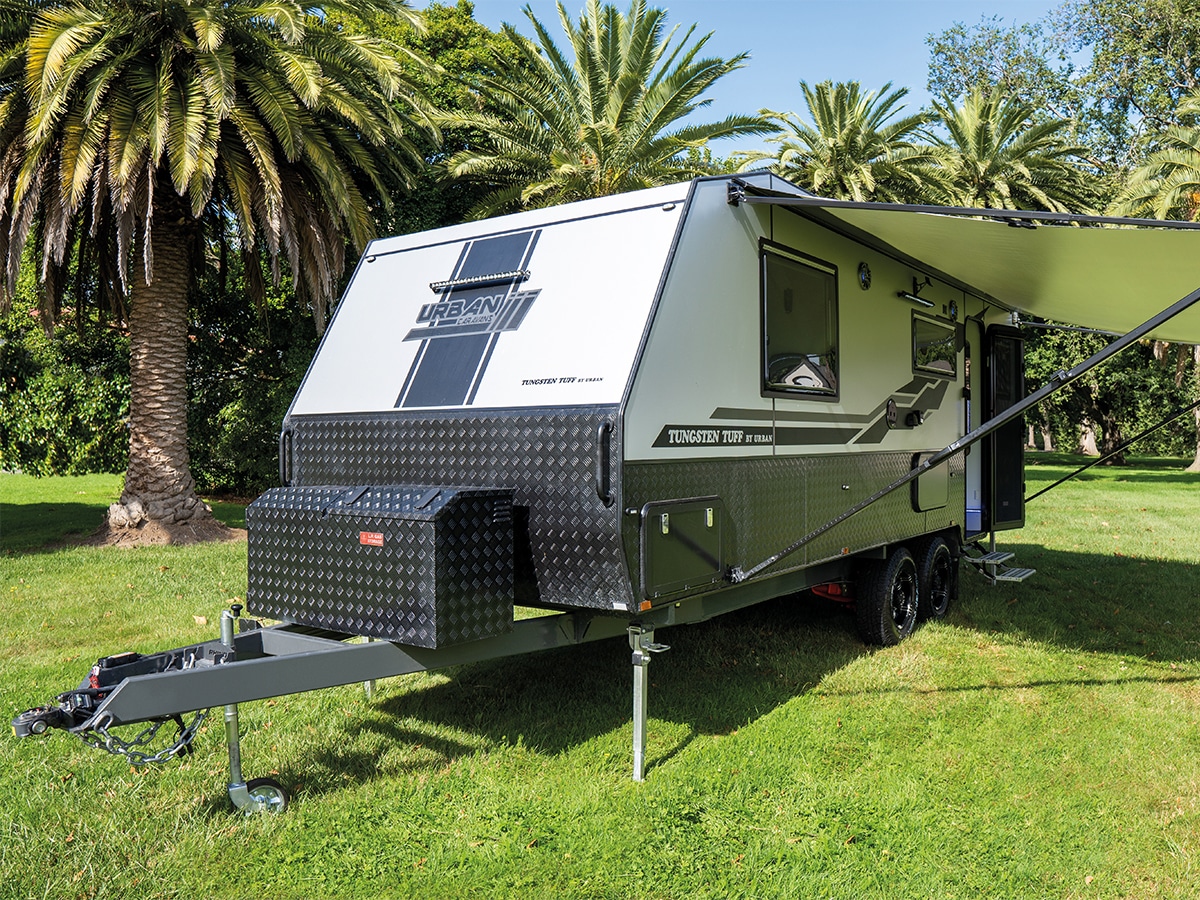Paul Owen reviews a resilient and well-crafted Australian-built caravan that’s built to take on even the most rugged of roads.
High-rise, armour-plated, semi-offroad Aussie caravans tend to look pretty similar from the outside, but there are some crucial differences to be found below the surface of these seemingly ready-for-anything behemoths. Australian manufacturers select various materials for their framing and often choose hardwood, and these constructions are mounted on a wide range of chassis, equipped with a mesmerising number of suspension options. The end results are caravans that all look like they will withstand a lot of rough surface abuse, but you won’t really know if that’s the case until you delve deep into the various specifications of each model.
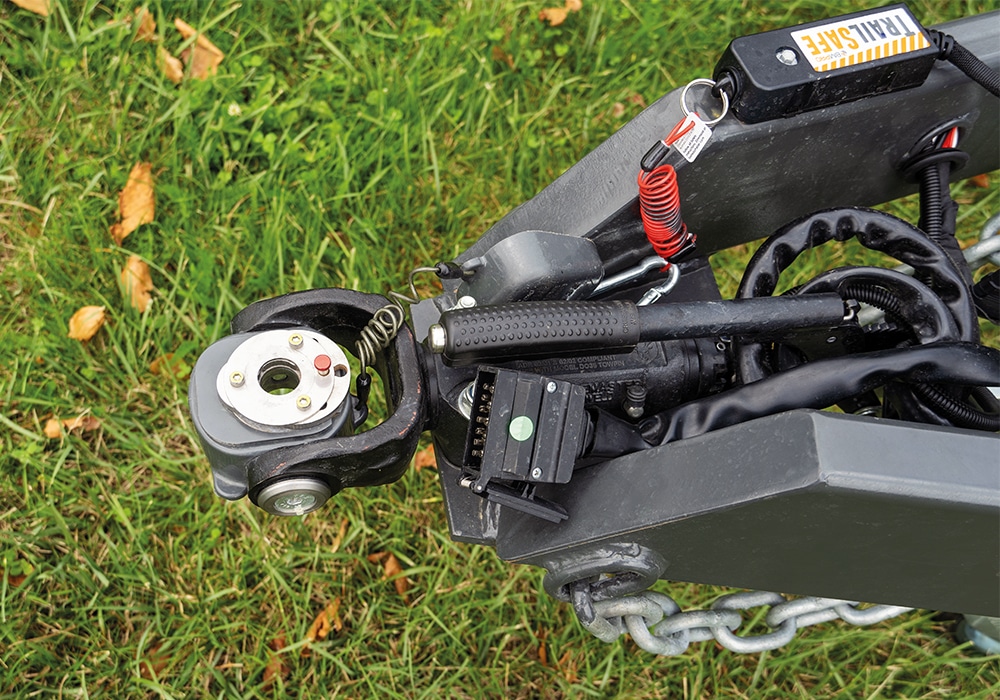
With this $151,890 Urban Tungsten Tuff model, you don’t have to look very far to know that this is a caravan that’s built to last. Perhaps the clue is in the model’s name, but dig deeper and the TT has all it requires to withstand mobile life in the harshest roadscapes. Urban are a low- volume manufacturer based in Victoria, but they got their start building bespoke caravans for the mining industry and government departments – mobile quarters that corporate teams of prospectors and public servants could tow into and out of the most isolated and uncivilised parts of Australia. It’s this experience that guides the design and engineering of the caravans that Urban now offers to the wider public.
“When you’re thinking of buying one of our caravans, it’s not just about what you can see,” says Andrew Mercer, manager of Fortis Group, the Palmerston North-based dealership for Urban caravans in NZ. “All Aussie caravans look the same, but when looking for the Urban difference, it all comes down to the construction – a lot of extra effort has been made to ensure that everything is all right.”
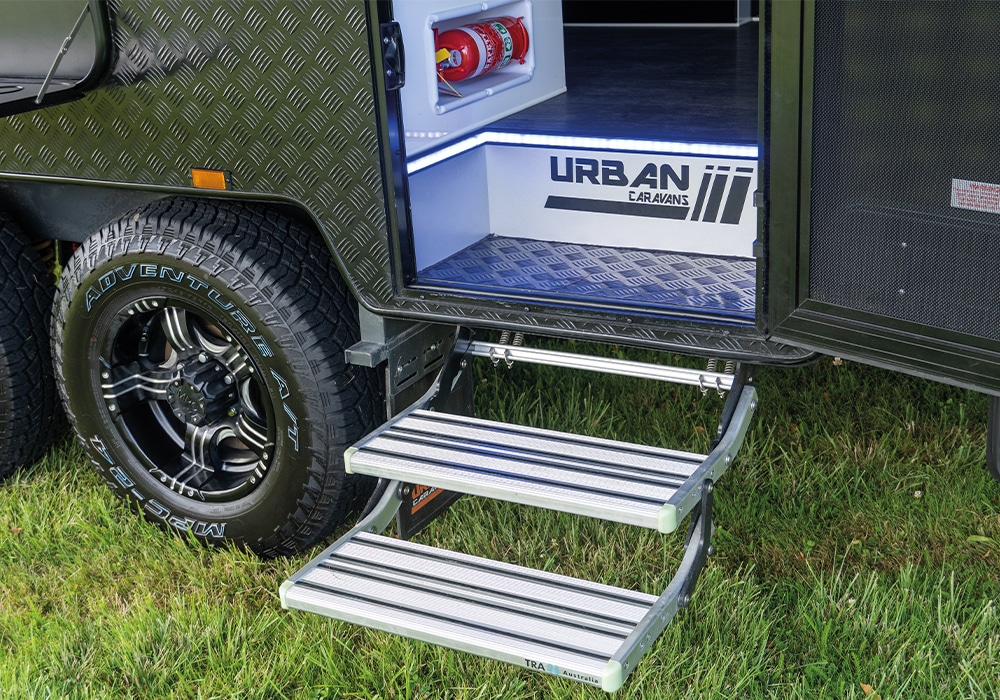
Tuff enough?
The Tungsten Tuff sits occupies the second tier of the Urban range and is the second- most popular model with New Zealand buyers. Top of the pops with Kiwi buyers is the shorter Tungsten Tourer, its less sophisticated suspension and coupling and other detail changes allowing it to occupy a price position in our market where it competes with a host of other Australian caravans. The Tourer is also available with either a single axle capable of carrying 2500kg or the 3500kg dual axle groupset shared with the Tuff. Both the Tuff and the Tourer sit on a Rhino steel chassis that is protected against corrosion by a galvanised zinc coating process called SupaGal.
SupaGal shouldn’t be confused with a similar process called DuraGal. The difference is that DuraGal only coats the external surfaces of the chassis with a layer of zinc that is between 50 and 80 microns thick, while SupaGal fully coats the 6” box-section steel beams and cross members of the Rhino chassis both inside and out (naturally this must be done before they’re welded together).
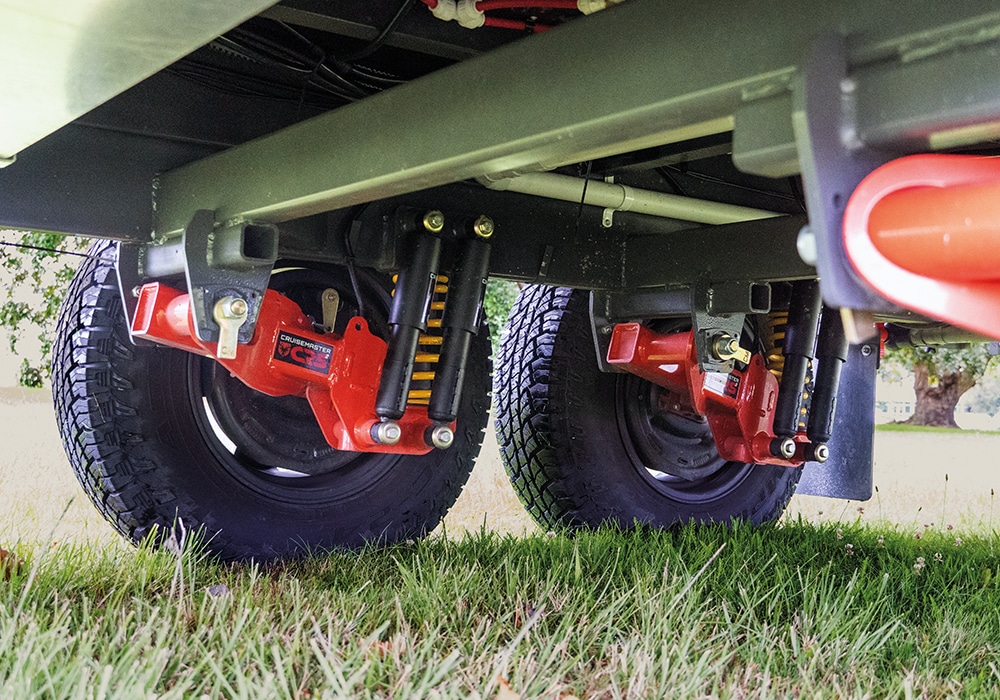
The Tuff is available with a steel chassis that has a substantially thicker layer of galvanised zinc, but Andrew says he tries to steer buyers away from it as the thicker adds 150kg of mass. The top of the range Tungsten X-Treme model, which Urban classifies as an off-road caravan while the Tuff is semi-offroad, comes with that thicker zinc coating on its chassis as standard, as it is the Urban model most likely to be towed along a beach.
The TT gets the same offroad-ready DO35 Hitchmaster coupling as the X-Treme, but not the 4.4 T Firestone airbag suspension of the off-road model. Instead, there are coil springs, each damped by dual shock absorbers, from Cruisemaster. It’s such a well-received and trusted setup that Urban also offer it as an option for the X-Treme.
Unlike the underpinnings of each Urban model, the construction that goes on top is fairly standard throughout the range. The body framing for each is made of square-section aluminium tubing, welded together using Tungsten Inert Gas (TIG), hence the use of ‘Tungsten’ in the model nomenclature. Why make such a big deal of it? TIG welds are far stronger than conventional welds, and about the only drawback to TIG welds is that they take more finesse to perfect. Rest assured that the welders working for Urban are highly practised at their craft, and that the joins are also secured with locking bolts.
The aluminium body frames are attached to the steel chassis using Z-plates for increased rigidity and strength, with stress bars added to absorb lateral twisting. Using welds to construct the frame means not riveting is required, and therefore there are no overlaps in the aluminium tubes, adding more rigidity again. It all results in a structure that in no way requires the reinforcement of body walls, floor, and roof for its integrity and strength.
The floor can therefore be made of one- piece honeycombed fibreglass for increased insulation and reduced mass. The roof is also a single fibreglass moulding bonded to a ceiling made of commercial grade Aluminum Composite Material (ACM), where two thin metal panels are bonded together with a middle layer of 20mm- thick polystyrene insulation. The walls are also made from ACM. The body panels are all attached to the ultra-durable frame according to the following mantra: glue it, screw it, cure it.
The result is a caravan that weighs 2824kg when unladen, and the slightly rearward bias of the weight distribution means that it places 195kg of downward pressure on the towball when hooked up. The maximum towable weight is 3305kg, meaning that you can load a maximum of 481kg of stuff into the TT. If opting for that thicker layer of galvanising, that payload lowers to 351kg.
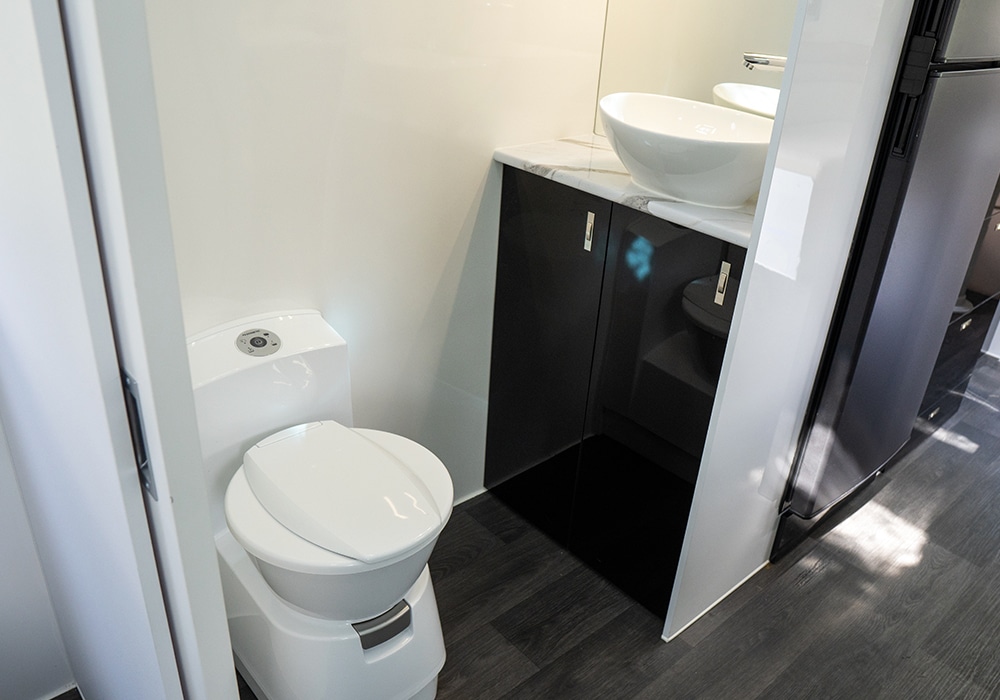
Centre or rear bathroom?
There’s a choice of six interior layouts for the Tungsten Tuff, and this example locates the bathroom in the middle instead of at the rear. There’s the ceramic-bowled toilet and washbasin on one side and a spacious shower cubicle on the other, with a sliding door at either end of the bathroom. These doors create extra privacy and sound deadening for the main bedroom, and the centre-bathroom layout is arguably the better choice for those qualities. By comparison, rear bathroom versions have a more open plan, and the interior therefore feels slightly more spacious upon first entry despite there being less light entering the cabin from the rear.
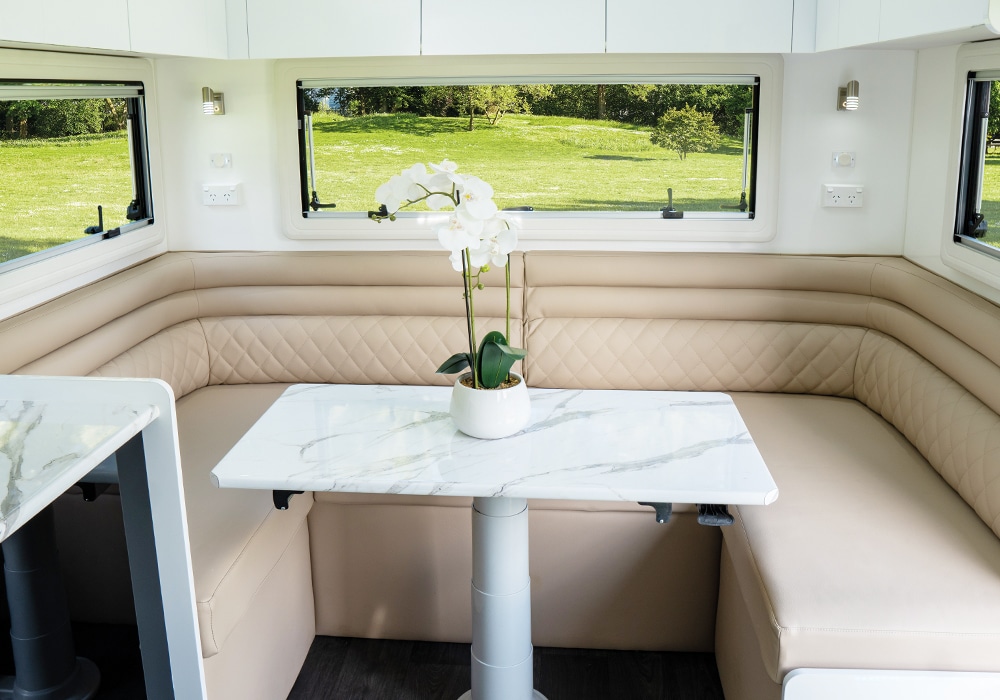
So, take your pick: the more European style with the centre bathroom or the authentic Australia-ness of the rear bathroom complete with Kath and Kim’s washing machine. This often-irrelevant appliance in New Zealand is stowed in a large cupboard adjacent to the U-shaped lounge at the rear of the centre bathroom version. Given the water and mains power demands of washing machines, it’s easy to think of better uses for this prime stowage location, and Urban’s ability to tweak and refine the fit-out to individual customer preferences makes it easy to modify that cupboard during the ordering process.
As for the U-shaped lounge, what a beaut! Its seating area is skillfully upholstered and there’s a window on each of the three sides, promoting both natural light levels and ventilation. If there’s not enough airflow and you’re hooked up to mains power, you can turn on the Ibis reverse-cycle air-conditioning system.
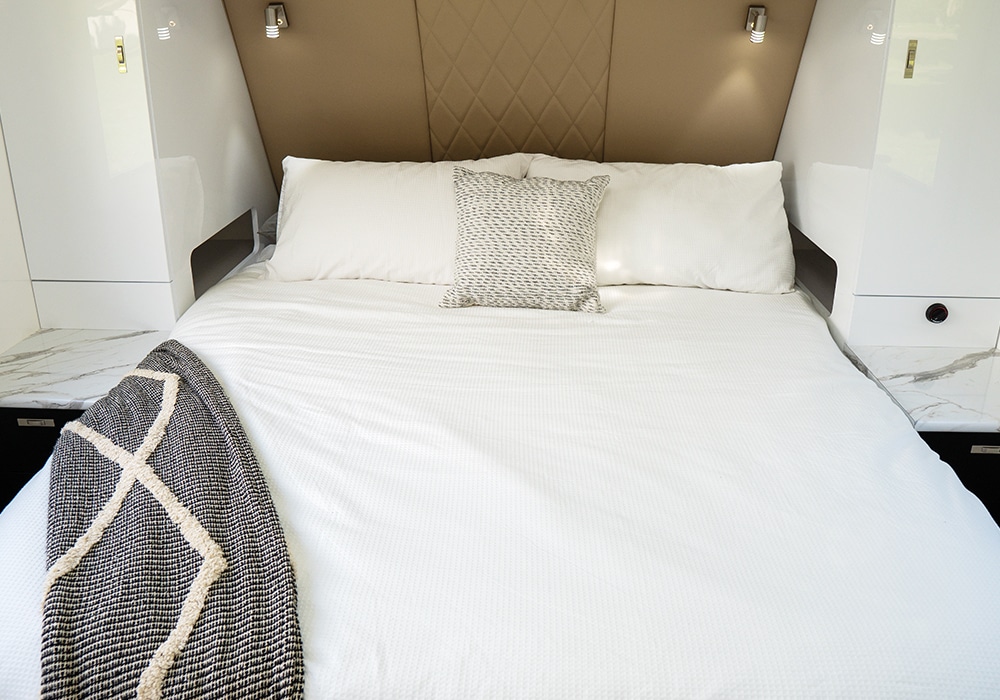
Crashing out
The rear lounge can be converted into a double bed, a secondary choice to the fixed double bed within its own enclosed room at the front of the TT. The presence of guests in that second bed will encourage the TT’s owner/occupiers to close the sliding door to the bedroom, an act that does reduce sleeping space a little. At 1.87m long, the innerspring main bed has the length required to suit 95 per cent of folk, however that last five per cent will resist any closing of the bedroom door. Besides, there’s a more agreeable perception of space if it can be left open, as the bathroom is a relatively roomy one.
Both the shower cubicle and the washroom/toilet area therefore have plenty of space, with no need to squeeze into either. Nice details include a full- width mirror above the wash basin, and a properly sealed pivoting door for the shower cubicle.
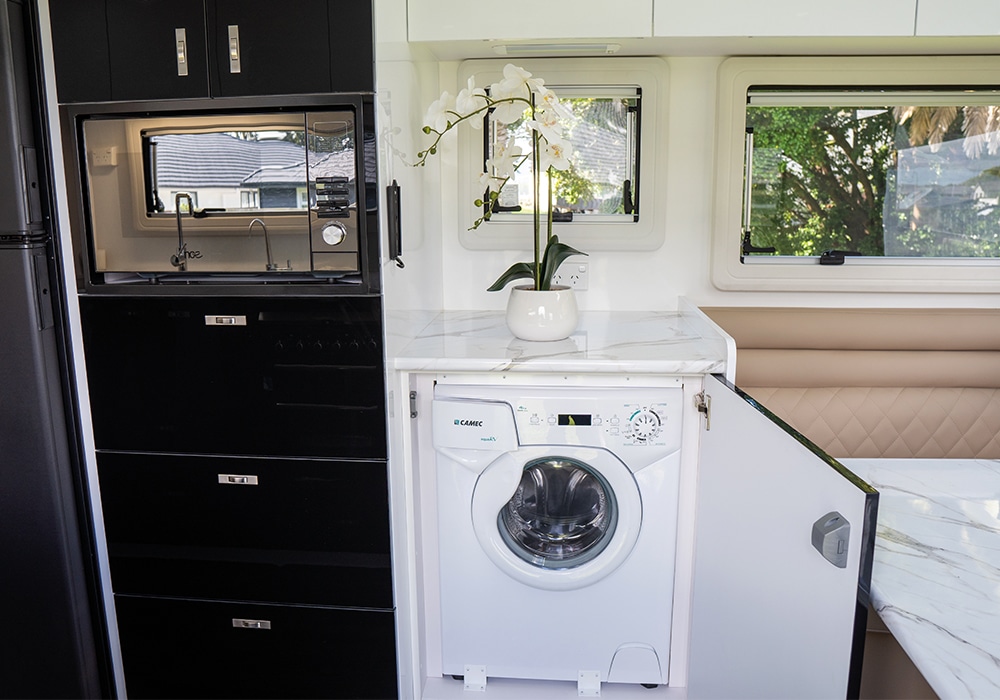
User-friendly kitchen
You can virtually remain in one spot when cooking and still enjoy plenty of preparation space, a large sink attended by a stainless-steel drainage plate, and full-monty gas cooking convenience with four burners, oven and grille and a rangehood to usher smoke and smells away. An about-face gives access to the large compressor fridge/freezer, microwave oven, and more cupboards and drawers. While you’re there, take in the quality of the cabinetry. The kiln-dried pine and poplar wood is cut into uniform shapes by CNC machines, joined into cupboards, drawers, and lockers with tongues and grooves for extra strength, then covered with the veneers of your choice. In the case of the review TT, these durable finishing veneers created gloss black and gloss white surfaces, which contrasted nicely with the marble-effect benchtops and the weathered cedar plank mimicking floor vinyl.

Lights, batteries, action!
There are plenty of LED lights to be found all over the Tungsten Tuff – inside and out, and in unexpected places like the support rail next to the entry door and the stairwell. The LED awning light even comes with a special trick – it repels insects, which is perfect if you’re resting a couple of cold ones on the fold-down picnic table and watching the 24” movable TV on its outside mount. The conveniences and appliances all draw power from the dual 120Ah AGM batteries of the TT, which are trickle charged by two 210W solar panels, and the network is managed through a BM35PRO battery management system and an Odyssey monitor and MPPT solar controller.
If that’s not enough off-grid power, Urban offers a factory-fitted upgrade called X-Grid, which X-Grid includes 4 x 210W solar panels, 2 x 200Ah lithium batteries, 2 x Dc-DC 50Amp MPPT chargers, and a BC300 shunt. Accoring to Andrew, X-Grid is a power upgrade that makes just about anything possible off grid – think coffee machines, induction cooking, hair-dyers, e-bike revival – the works. “It’s so much better than getting these things retro-fitted,” he says.
Roll your own
Whether you want your Tungsten Tuff to have X-Grid or not is just one of the many things to think about when placing your order for one, as there is also a myriad of furnishing options available. That’s one of the great things about buying a caravan made by a relatively low volume manufacturer like Urban. The flip side is that the current lead time between placing an order and towing the caravan away for the first time is 14 months, an interval that Andrew says Urban is working hard to shorten. The payoff for being patient, however, is that you will arguably be towing one of the strongest and most resilient caravans in the world.
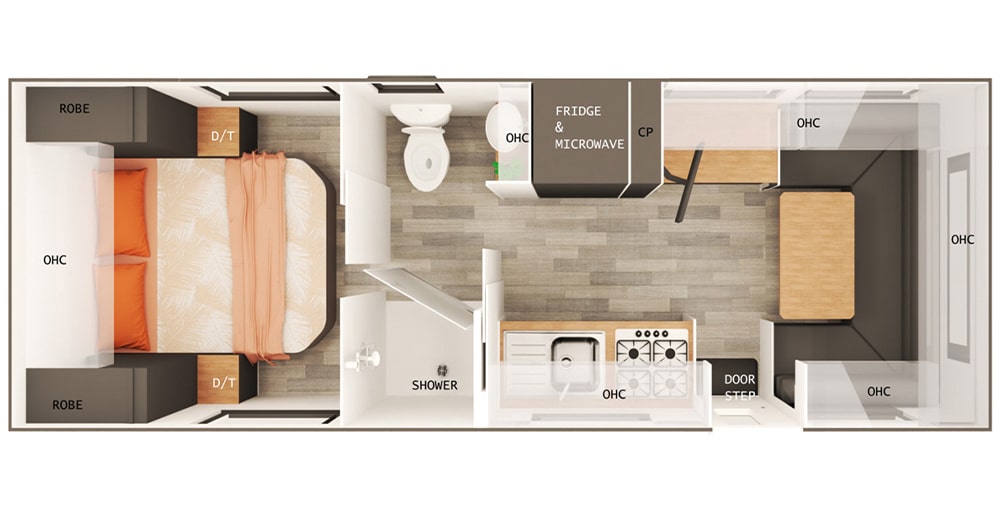
For more information, visit https://www.fortiscaravans.co.nz/off-road-caravan-models
You can also customise your own van, follow this link https://www.fortiscaravans.co.nz/build-a-van
| SPECIFICATIONS | |
|---|---|
MAKE & MODEL: | Urban Tungsten Tuff 22ft |
| CHASSIS: | Rhino steel trailer with dual-axle independent suspension and DO35 coupling |
| LENGTH/WIDTH: | 6755mm/1975mm |
| BERTHS: | 4 |
| FRESH/GREY/HOT WATER: | 2x95L/95L/23L (continuous available) |
| GVW/PAYLOAD: | 3305kg (unladen mass: 2824kg) |
| PAYLOAD: | 481kg |
| PRICE: | From $151,890 |

